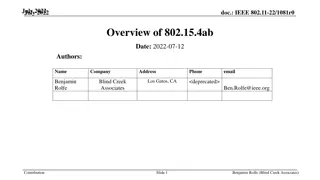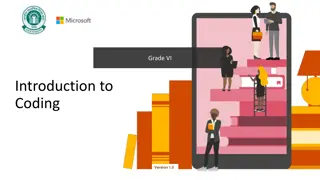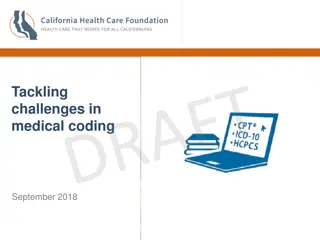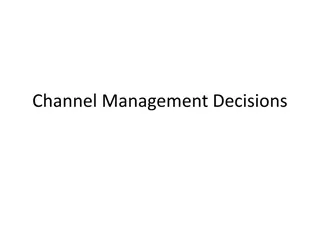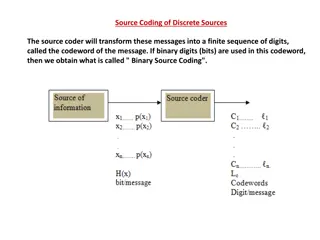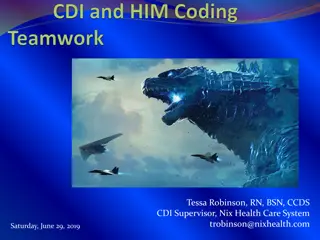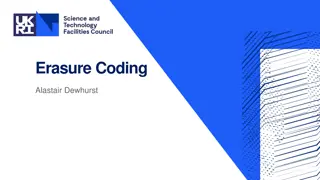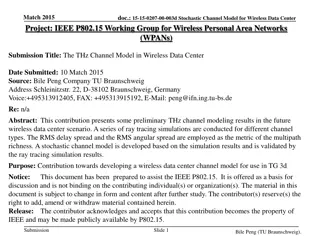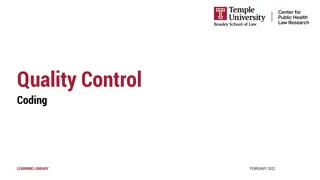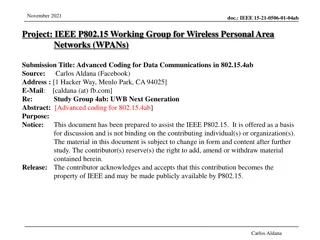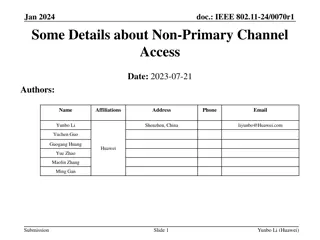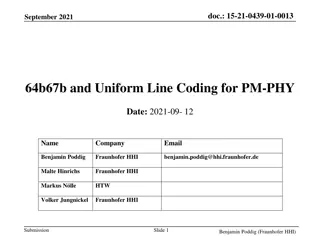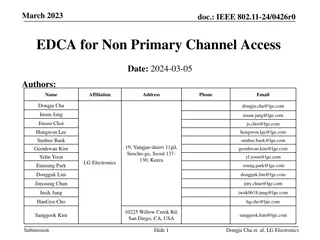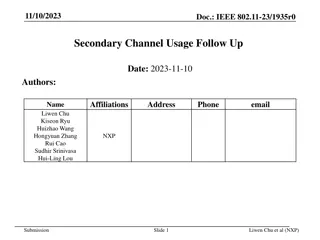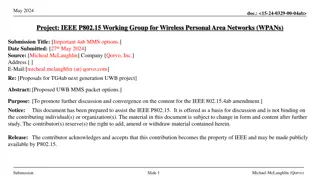Further Considerations on Advanced Channel Coding for 15.4ab
This document submitted to the IEEE P802.15 Working Group discusses the importance of advanced channel coding for IEEE 802.15.4ab standard to achieve higher throughput and reliability. It outlines technical guidance on proposed solutions, safeguards, interference mitigation techniques, and backward compatibility considerations. The document also highlights related submissions and provides an overview of channel coding considerations in the IEEE standards. Various improvements such as new channel coding schemes, additional channels, operating frequencies, accuracy enhancements, improved link budgets, and reduced power consumption are proposed to enhance the performance of wireless personal area networks (WPANs).
Download Presentation

Please find below an Image/Link to download the presentation.
The content on the website is provided AS IS for your information and personal use only. It may not be sold, licensed, or shared on other websites without obtaining consent from the author. Download presentation by click this link. If you encounter any issues during the download, it is possible that the publisher has removed the file from their server.
E N D
Presentation Transcript
March 2022 doc.: <15-21-XXXX-00-04ab> Project: IEEE P802.15 Working Group for Wireless Personal Area Networks (WPANs) Submission Title: [Further Considerations on Advanced Channel Coding for 15.4ab] Date Submitted: [10th March 2022] Source: [Jiaqi Gu, Wei Lin, Xun Yang] Company [Huawei] Address [Huawei base, Shenzhen, CHINA] E-Mail:[lin.linwei@huawei.com] Re: [Study Group 4ab: UWB Next Generation] Abstract: [Further Considerations of Advanced Channel Coding on 15.4ab] Purpose: [] Notice: the contributing individual(s) or organization(s). The material in this document is subject to change in form and content after further study. The contributor(s) reserve(s) the right to add, amend or withdraw material contained herein. This document has been prepared to assist the IEEE P802.15. It is offered as a basis for discussion and is not binding on Release: The contributor acknowledges and accepts that this contribution becomes the property of IEEE and may be made publicly available by P802.15. Wei Lin (Huawei) Submission Slide 1
March 2022 doc.: <15-21-XXXX-00-04ab> Technical Guidance PAR Objective Proposed Solution (how addressed) Safeguards so that the high throughput data use cases will not cause significant disruption to low duty-cycle ranging use cases. Interference mitigation techniques to support higher density and higher traffic use cases Other coexistence improvement Backward compatibility with enhanced ranging capable devices (ERDEVs). Improved link budget and/or reduced air-time New Channel Coding Schemes can provide improved link budgets and reduced air time Additional channels and operating frequencies Improvements to accuracy / precision / reliability and interoperability for high-integrity ranging; Reduce complexity and power consumption; Hybrid operation with narrowband signaling to assist UWB; Enhanced native discovery and connection setup mechanisms; Sensing capabilities to support presence detection and environment mapping; Low-power low-latency streaming higher data-rate streaming allowing at least 50 Mbit/s of throughput. New Channel Coding Schemes with higher rates can support high data rate Support for peer-to-peer, peer-to-multi-peer, and station-to-infrastructure protocols; Infrastructure synchronization mechanisms. Wei Lin (Huawei) Submission Slide 2
March 2022 doc.: <15-21-XXXX-00-04ab> Related Submissions [1] 15-21-0506-02-04ab-Advanced Coding for Data Communications in 802.15.4ab, Aldana [2] 15-21-0592-00-04ab-high-data-rates, Murray, et al [3] 15-22-0050-00-04ab-Channel Coding Considerations for 802.15.4ab, Wei Lin, et al Wei Lin (Huawei) Submission Slide 3
March 2022 doc.: <15-21-XXXX-00-04ab> Channel Coding Considerations Overview [3] As of today, IEEE 802.15.4z standard allows for data communication of small amounts of data with speed of a few tens of mbps. No Capacity-Approaching FEC codes (LDPC, Turbo, Polar, etc.) have been adopted yet IEEE 802.15.4a employed a rate-1/2 convolutional code of K=3 (4 states) as well as an (63, 55) GF(26) Reed-Solomon Code. To further enhance the performance, 802.15.4z optionally introduced an standard rate-1/2 convolutional code of K=7 (64 states). For 802.15.4ab, the needs for higher throughput as well as higher reliability have been discussed. Introduction of advanced coding has been discussed in [1], [2] [3] Wei Lin (Huawei) Submission Slide 4
March 2022 doc.: <15-21-XXXX-00-04ab> Channel Coding in 15.4ab In [1], LDPC codes have been analyzed and suggested as an option for 802.15.4ab The consideration of introducing new advanced coding schemes were discussed in [1][2][3] [1] proposed to include LDPC codes as an optional solution after an extensive comparison of Turbo, Polar, NR LDPC, and 802.11n LDPC codes [2] proposed to identify suitable candidate advanced codes for high-speed data, e.g., NR LDPC, 802.11n LDPC, candidates for Turbo and Polar codes, and possibly additional LDPC codes Power consumption at a given performance should be a central selection metric [2] In this contribution, we further analyze Polar, LDPC, Turbo and CC codes in terms of computational complexity, error correcting capability (BLER performance) and power consumption. Wei Lin (Huawei) Submission Slide 5
March 2022 doc.: <15-21-XXXX-00-04ab> Channel Coding Consideration in 15.4ab Complexity [1] Code Complexity Polar LDPC Turbo TBCC SC: O(N*log2(N)) +O(N-1) Additions:Imax*O(2*N*dv + M*(2*dc-1)) Look up table operation: Imax*O(M*dc) Addition:Imax*O(16*K*2m) Max operation: Imax*O(8*K*2m) List Viterbi: 3*K*O(3*S+16) + K*O(2*S*L+16) + K*S*L SCL: O(L*N*log2(N))+O(N- 1)+K* O(2*L*log2(2*L)) Note: SC: Successive Cancellation; SCL: Successive Cancellation with List An example of computational complexity comparison between Turbo(N=1944), LDPC(N=1944) and Polar (N=2048). Reference: 3GPP R1-164040 On latency and complexity Wei Lin (Huawei) Submission Slide 6
March 2022 doc.: <15-21-XXXX-00-04ab> Channel Coding Consideration in 15.4ab Complexity [1] Another example of a short block length code between CC(N=72,R=0.76) and Polar(N=72 with mother code length 128). Observations Polar with SC decoder has a very low complexity which makes it energy and area efficient for large block length The complexities of both Polar & LDPC decoders are less than 80% of a Turbo decoder with 8 iterations Reference: 3GPP R1-164040 On latency and complexity Wei Lin (Huawei) Submission Slide 7
March 2022 doc.: <15-21-XXXX-00-04ab> Channel Coding Consideration in 15.4ab Error correcting capacity Polar code performs very well at short codeword lengths, e.g., N = 128 bits There are performance gap between 11n LDPC and Polar codes, thus the performance of 802.11n LDPC codes need to be further enhanced, i.e., new LDPC codes Wei Lin (Huawei) Submission Slide 8
March 2022 doc.: <15-21-XXXX-00-04ab> Channel Coding Consideration in 15.4ab Error correcting capacity Performance comparison between Polar, LDPC, and Turbo codes in AWGN, with several codeword lengths Note: CA SCL means CRC-aided SCL Polar codes with CA-SCL decoding outperforms turbo code up to around 1 dB, especially in the case of small packet sizes LDPC codes can also outperform Turbo codes at short/medium lengths and medium/high rates Reference: 3GPP R1-162230 Discussion on channel coding for new radio interface Wei Lin (Huawei) Submission Slide 9
March 2022 doc.: <15-21-XXXX-00-04ab> Channel Coding Consideration in 15.4ab Power consumption 95.54mW 158.38mW Suitable for scenario when high-throughput or low-latency is required Suitable for scenario when smaller chip size or lower energy consumption is required Assume power scales as s, where s is the technology feature size Power consumption varies with architectures/design targets/criteria, but the power consumption of most polar & LDPC decoders are less than 100mW, while Turbo decoder requires relative higher power consumption Wei Lin (Huawei) Submission Slide 10
March 2022 doc.: <15-21-XXXX-00-04ab> Channel Coding Consideration in 15.4ab Candidate coding scheme comparison: Polar LDPC Turbo CC Good power/area efficiency Low power/area efficiency When the block length is large and code rate is smaller than 1/3, CC performance is poor Small-list decoder or SC decoder for good power and area efficiency Large Block(e.g. >8k) Good performance when rate is higher than 1/2 Good performance Relative good performance When the block length is large and code rate is smaller than 1/3, CC performance is poor Medium-List decoder for good performance for all rates, support various rates and lengths 1k~8k blocks Support a relative fine granularity of rates and lengths Support a relative fine granularity of code rates and code lengths Not very good performance with small block and low code rates Poor performance with small block VA decoder has poorer performance than SCL Polar Large-List decoder for very good performance Small block, ultra reliability Error Floor LVA decoder has much higher complexity than Polar List decoder. Support very low code rate New LDPC needed HARQ required for high reliability Not very good performance with very small block Poor Performance with very small block Viterbi Decoder for low-power realization; Small-list decoder or SC decoder for low-power realization Very Small block, low power consumption Performance is worse than SCL decoder New LDPC needed Reference: 3GPP R1-164039 Polar codes - encoding and decoding Wei Lin (Huawei) Submission Slide 11
March 2022 doc.: <15-21-XXXX-00-04ab> Channel Coding Consideration in 15.4ab Candidate coding considerations in 15.4ab Both Polar and LDPC codes can achieve a decoding power consumption of <100mW No error floor exists for polar code, as list size increases, non-saturated performance is maintained, which is affordable by the ever-developing ASIC technology LDPC codes are widely adopted by various standards, and perform well at long code lengths, so they also should be considered The performance of 802.11n LDPC Codes need to be further enhanced, i.e., new LDPC codes When the block length is small, the LTE-Turbo code performance degrades Wei Lin (Huawei) Submission Slide 12
March 2022 doc.: <15-21-XXXX-00-04ab> Summary Both Polar and LDPC codes should be considered for 802.15.4ab The performance of 802.11n LDPC Codes need to be further enhanced, i.e., new LDPC codes Wei Lin (Huawei) Submission Slide 13
March 2022 doc.: <15-21-XXXX-00-04ab> Thank You Wei Lin (Huawei) Submission Slide 14





